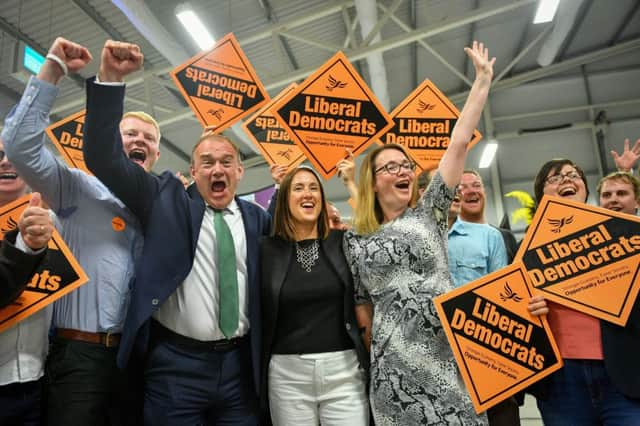How Liberal Democrats will repeat Welsh tactics in battle to replace Jared O’Mara in Sheffield: Andrew Vine


The Liberal Democrat victory in Brecon and Radnorshire, which overturned a Conservative majority of more than 8,000, doesn’t only bring a general election that much closer by cutting the Prime Minister’s working majority to only one.
It also sounds warning bells for more than a dozen Yorkshire constituencies – both Labour and Conservative – where the sitting MPs have majorities of less than 8,000. A pact between the Liberal Democrats and Greens did for the Tories in one of the loveliest parts of Wales, and similar deals could be enough to pick off constituencies from the two largest parties in our region.
Advertisement
Hide AdAdvertisement
Hide Ad

That should be a worry for them, each as they are tied in knots over Brexit and unable to rely on traditional party loyalties to hold seats even by very narrow margins.
And in a few weeks’ time, Yorkshire is likely to provide the next target for a pact between Lib Dems and Greens that proved so successful in Brecon and Radnorshire. The battleground will be in Sheffield Hallam, following the resignation of its MP, Jared O’Mara, which he has said will happen next month when Parliament returns from recess.
Labour’s majority in 2017 – before Mr O’Mara first had the whip withdrawn and then quit the party to sit as an independent – was a relatively slim 2,125 and the Lib Dems will fancy their chances of winning the seat back.
They had held it since 1997 after overturning a healthy Tory majority, first with Richard Allan and then their former party leader, Nick Clegg, both of whom were well regarded and popular constituency MPs, which means there is a lot of residual goodwill towards the Lib Dems there among voters with longer memories. Mr Clegg’s defeat had much to do with the campaign against him personally over his U-turn on opposing increases in student fees while in coalition with the Conservatives. That all feels like ancient history now and if the Lib Dems form a pact with the Greens not to oppose them, Sheffield Hallam could be theirs once more.
Advertisement
Hide AdAdvertisement
Hide AdIf a pact works in Sheffield, just as it did in Wales, there’s every reason to suppose that it might work elsewhere in Yorkshire as well, which is worrying for MPs with very slender majorities, especially given how polarised the two major parties have become.
Labour has lurched to the left under Jeremy Corbyn, and the Conservatives to the right under Boris Johnson. Both positions potentially repel as many voters as they attract. For the Tories, the position is further complicated by their vulnerability to attack by Nigel Farage’s Brexit Party, which could deny victory in close-fought constituencies by splitting the vote on the right.
Add that to the pressure coming from the Lib Dems and Greens, and it could be the factor that sees some Yorkshire constituencies change colour from blue to yellow on the election results map. Conservatives will hope that one of the counters to that happening is the charisma and what they believe to be the broad electoral appeal of Boris Johnson.
But the real popularity of Mr Johnson in our part of the world remains hard to gauge. Yes, the opinion polls put him well ahead of Jeremy Corbyn as the person those questioned think would make the best Prime Minister, but such polling is being done when Parliament is not sitting.
Advertisement
Hide AdAdvertisement
Hide AdVoters have not yet seen how Mr Johnson tackles the deadlock over Brexit, which becomes that much more difficult now his working majority is down to one and he has backbenches full of disgruntled ex-Cabinet ministers sacked during his first hours in office, or those who resigned rather than serve under him. Let’s not forget that at the start of her premiership, Theresa May was riding so high in the opinion polls that she called an election confident that Labour would be trounced. We all know what happened next.
Currently, all voters have to go on are promises. And yes, Mr Johnson’s pledge to fund a high-speed railway between Leeds and Manchester was widely applauded, as it deserved to be. The Conservatives will win votes on the back of that pledge to address a problem neglected for so long, and they will deserve to do that too.
But the Prime Minister has been less forthcoming about supporting the One Yorkshire plan for a proper devolution deal for our county, and until he agrees it, for many voters in this region he remains an ever-so-slightly slippery figure who talks a good game but will need to prove he can deliver.
Charisma and personal appeal, whether from Mr Johnson or Mr Corbyn, might not be enough for either to hang on to Yorkshire seats targeted by a determined new coalition which believes it has found a winning formula.